WELCOME!
MY PICKS FOR THIS YEAR ARE:
CLOVERFIELD, DIARY OF THE DEAD, THE MIST & GRINDHOUSE: PLANET TERROR
|
MIRRORS (2008)
dir: Alexander Aja (THE HILLS HAVE EYES(2006), HIGH TENSION)
Keifer Sutherland stars in this remake of a Korean horror pic. Same old same old basically. If you've seen any of the recent J-Horror works from Japan, you don't need to see this. Sort of a combination of 1402 and SILENT HILL and of course, THE GRUDGE. It seems that most horror outings these days center around visual shocks- usually based on the latest in CGI tech- and the story is secondary. The premise of an angry ghost seeking revenge has become more than just cliche at this point- it's almost a genre unto itself. Ever since THE RING (another Asian remake in the USA) we've been over-run with ghost stories that have really provocative set-ups and seriously paltry third act climaxes. These stories seem to run out of gas and rely on special effects and explosions to cover their lack of a finale. Keifer Sutherland wasn't particularly memorable. Paula Patton is incredibly sexy, but Amy Smart gets about 1 minute of canned screen time- just long enough to appear naked in the tub and get her jaw ripped off. Soundtrack a bit too orchestral, although there were some very nice subtle passages- almost non musical- creating tension in act 2. I'd say skip this one.
| |
THEM (2007)
dir: David Moreau & Xavier Palud
A terrific point-of-view thriller from France. I like horror films that are really basic dramas, but told from the viewpoint of a victim- so that an otherwise standard story becomes a thriller. A young couple spend the weekend in a rural home when they are attacked by unseen predators. Without any clue who is after them, the couple struggle to survive a deadly chase in the house and eventually into the woods. The use of sound and camera angles turns a normal farm house into a truly creepy world of tension. The ending finally reveals the nature of the predators, which is shocking enough to leave us either with a huge socio-political problem to consider; or a giant shaggy dog story- feeling a bit like the beginning of a provocative social drama, rather than the climax of any succint horror premise. Nonetheless, The POV treatment of the film was effectively haunting. Terrific score as well.
| |
ALIEN VS. PREDATOR: REQUIEM (2008)
dir: Colin & Greg Strause
Oh boy, skip this one. The first AVP was a bit of a fun drive-in flick- stupid, but fun in a beer drinkin' way. I also loved the score. This time, a special effects company in L.A. got the rights to the franchise and basically used it as an excuse to practice their FX. Nothing new is offered here. Pretty bad all the way around. The one element i liked came at the end when the town is over-run by aliens and the survivors must make a choice whether to fight or flee. Nice little apocalyptic zombie type feel for about 30 seconds. The ending turned into your basic "evil government conspiracy" crap. The whole film is purposely shot really dark too, which was annoying.
| |
BLACK SHEEP (2008)
dir: Jonathan King
From New Zealand - first time director horror/comedy in the vein of SHAUN OF THE DEAD. I really looked forward to this one after seeing the trailer. However, not quite as absurd as i would have liked it. ALthough the film was satirical enough, it was almost too interested in making a good story. I would have preferred a bit more of a SPINAL TAP treatment. If you like "drive-in" flicks like TREMORS or SLITHER, this might be for you.
| |
THE MIST (2007)
dir: Frank Darabont (THE GREEN MILE, THE SHAWSHANK REDEMPTION)
Cthulu comes to town in this Stephen King meets H.P. Lovecraft meets John Carpenter sociological drama. The opening shot of the movie reveals our hero character in his studio with his paintings on the wall- the centerpiece of which is the poster image from John Carpenter's THE THING. From the beginning we know exactly what kind of ride we are in for!
Frank Darabont once again adapts a Stephen King short story for the screen and directs the film with a Hitchcockian respect for the story's character drama. Similar to TWELVE ANGRY MEN and following in the great tradition of thrillers about random characters trapped together in a confined space (THE THING, Romero's DEAD series, CUBE, IDENTITY) THE MIST explores moral and ethical crisis in a situation were reality itself is in question. "People are fine as long as the machines are working," explains David (Thomas Jane), "but take that away and they'll turn to whatever offers them an answer." Academy award winner Marcia Gay Harden plays Mrs. Carmody the films human religious-kook antagonist. William Sadler does a terrific job portraying an impressionable local hick. Masterfully, the musical score stays out of the way until nearly half way through the film. The special effects are top-notch.
Rather than going for shocks and scares, THE MIST uses it's story to meditate on ethical human drama. What would you do if monsters suddenly showed up? How would you explain it to your children?? The films' characters bear the burden of having to make epic decisions without all the information. Science Fiction allegories like THE MIST create opportunity to test the human experience by putting everyday characters up against fantastic scenarios like creatures from other dimensions "that should not be." This dynamic forces us to meditate on the nature of how we perceive reality, and ultimately, choose to believe what we believe. Although quite heavy-handed, the films' ending offers an incredibly powerful play on the peril of making ethical decisions. What we take away from THE MIST in not so much the fantastic angle of it's story, but hard truths about the inescapability of the human condition.
| |
THE INVASION (2007)
dir: Oliver Hirschbiegel (THE EXPERIMENT, MORTAL FRIENDS)
Another film version of Jack Finney's classic novel INVASION OF THE BODY SNATCHERS, this time starring Nicole Kidman and Daniel Craig. There are many stories in film and literature that deserve re-telling era to era because their thematic premises are universal and timeless. I wrote about this idea in my reviewz of Peter Jackson's KING KONG(2006) and Rob Zombie's HALLOWEEN (2007). In today's remake frenzy, many classic movies are being remade for their surface stories, while their subsequent central themes are missed. German director Oliver Hirschbiegel re-visits the INVASION OF THE BODY SNATCHERS story with yet another spin on the replacement of the individual by emotionless clones. While the film is well-made and faithful to content in previous versions of the story, it unfortunately fails to deliver the emotional impact of the original or the other remakes.
In 1956, director Don Siegel introduced the original red-scare allegory of alien pods that mimic and replace human individuals. The story was revisited in 1978 by Philip Kaufman and again in 1993 by Abel Ferrara. In the '78 version, Kevin McCarthy makes a cameo appearance, reprising his role from the original film which ends with him yelling at traffic "they're coming! they're coming!" Borrowing from this tradition, Veronica Cartwright, (a
supporting character in the 1978 film) plays a pivotal supporting character in this 2008 version. The 1993 film by Abel Ferrara was a bit more insular with it's metaphor on AIDS, but with an equally apocalyptic ending as the '78 version, in which an alien character (Meg Tilly) scorns humanity, charging, "Where you gonna go? What are you gonna do? 'Cuz there's no one like you left?"
| |
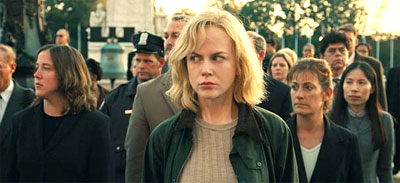 |
| 2008 |
|
| |
When the space shuttle "Patriot" burns up in orbit over
Texas, the fragmented remains bring with them a space virus that
quickly infests humanity. This new story angle plays on references to
government conspiracy and
media cover-ups rather than contemplate any otherworldly
end-times. People are "taken over" when those already possessed vomit
green goo onto them. There are, however, a certain percentage who are
immune do to having had
a rare chicken-pox strain in childhood. This is the
first version to offer a happy ending- resolving the pandemic as a
virus that can be cured. Whereas pasts re-tellings centered on the
contemplation of "what makes an individual" and the paranoia over how
easily emotion can be taken away by logical fascism, this story skips
almost all of this content in favor of far less internalized concepts
of government mistrust. It would seem the films greatest flaw is in
it's social premise. If the point of the allegory is how we are easily
led sheep, in the same way that the 2005 remake of DAWN OF THE DEAD
failed by missing the subtext of the original, THE INVASION shoots
itself in the foot by making the point of the allegory a ""virus"
rather than an alien intelligence. Although it's explained as
"intelligent" it is played as a biological plague of nature rather than a
play on man-made fascism. The idea from the '78 version of "don't show
emotion and you can blend in" is repeated in this version, but to a far
less poignant degree. It is in keeping with this era's thrillers that
the film focuses more on explaining things than drawing metaphors (Rob
Zombie's: HALLOWEEN, DAWN OF THE DEAD). The films' upbeat ending suggests
that such tragedies are mere missteps rather than timeless evils, thus
drawing very different ethical conclusions. Despite its desire to infer conspiracy, there's just not enough conspiracy. Although the classic
creepiness of emotionless clones taking over the world is realized in
THE INVASION, the important themes of the previous film versions are
mostly missed.
|
30 DAYS OF NIGHT (2007)
dir: David Slade (HARD CANDY)
Vampires in small Alaska town as sun disappears for one whole month- the longest "day" of the year. A terrific premise for a vampire flick. There was a real insular feeling in the production design- shot on sets- which somehow lended to the films' claustrophobic feel. Not a good film, but had elements that were lasting. High point was a group of survivors holed up in an attic where they cannot make any sound. Reminiscent of THE THING a bit. The ending was a bit too BLADE-ish and all-too-easily wrapped up. There was no explanation as to the vampires origins or any wide-reaching story. The film was basically a quick set-up for an action plot. There is a series based on the film that is online i believe. I don't necessarily recommend, but many folks found this one really scary.
| |
DIARY OF THE DEAD (2008)
dir: George A. Romero's (NIGHT OF, DAWN OF, DAY OF and LAND OF THE DEAD)
Veteran horror maestro George Romero points the camera into the mirror to question the role of image making in modern culture- in this fifth in his zombie "DEAD" series. If you put CLOVERFIELD, THE BLAIR WITCH PROJECT and Wes Craven's: A NEW NIGHTMARE into a blender- you'd end up with a DVD of DIARY OF THE DEAD on your kitchen counter.
The film opens with a group of film students shooting a zombie movie in the woods. The director scolds the actor playing the zombie for moving too fast. "Zombie's move slower than that!" he cries. The actress playing the hapless girl chides the director, "why does the girl always have to trip and fall?" and, "you just wanna see my boobs!" In the third act, the actor- now an actual zombie- chases the same girl for real this time. The director kid films it all on a video camera noting that the irony is too strong not to film it. The girl trips for real and they laugh. "I'll get you for this!" she exclaims. "See!" the director yells, "zombies really do move that slow." All the while the actual zombie- still dressed in his cheezy zombie actors wardrobe- actually tries to catch and eat the girl. "Will you put the camera down and help a little!" the girl says. "This is too good, i have to get it" replies the director. If ever there was a self-reflexive moment of horror satire, it is this scene.
The film students, hunkered in their production camper, trek across the state to a rich friends compound. On the way, they decide that their role in this crisis should be to "document the truth." With state-of-the-art technology like streaming internet video, they observe the bias in the mainstream media and authorities tendency to censor details. The students take it upon themselves to bear witness to the truth as they experience it. There are clear references to the present war in Iraq and all the other media challenges of our YouTube culture. At this level, DIARY OF THE DEAD becomes a deeper extension of the same concerns presented in this year's CLOVERFIELD.
| |
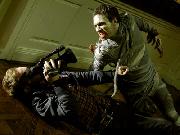 |
| THE CAMERA AS A WEAPON |
|
|
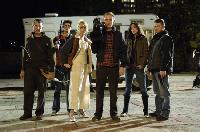 |
| TUNED IN, TURNED ON AND STILL ALIVE |
|
|
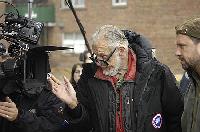 |
| ROMERO: IMITATING-ART-IMITATING-LIFE |
|
|
Romero once again uses his
zombie premise to comment on timely social issues. In this chapter,
humanity is clearly going to survive and the story ends with the
walking dead marginalized and contained. However, the end doesn't come
without one of the main characters documenting his own death on
camera. In a poignantly realized scene, we witness the young man
literally fighting off a zombie (once his friend) with his video
camera- the only weapon he has. Perhaps any mechanism for seeing
ourselves objectively, is the only way out of the Pandora's box our
social unconscious has become. In a haunting final image, a group of
backwoods hicks have a live zombie girl strung up in a noose and use
her for target practice. Is a society so able to lose its own humanity
actually worth saving?
DIARY
is not a good horror film per-se. However, it is a radical essay that
uses the horror milieu as its vehicle. Of course, one might argue that
this dynamic is precisely what makes a good horror movie "good." Adding another level is the fact that the filmmaker using this genre (Romero) is the guy who originally created it.
This is a film that could (and should) inspire hours of discussion in
film class. Although, much of the action could have been done better
in my view, the suspension of disbelief is not as critical in this film
as it must be in others. To use the term "tongue in cheek" would be
an oversimplification. To horror fans, DIARY should be a guilty
pleasure. To cinema buffs, its an essay piece. To the uninitiated,
it's most likely a conundrum. What's most striking to me is how
Romero's allegory of walking undead works decade after decade. The
metaphor seems to fit again and again with whatever present issues
exist in our culture. After LAND OF THE DEAD i sort of wondered if
Romero shouldn't quit the series. After DIARY OF THE DEAD, I'm sorta
hoping he makes these films forever.
Thanks to FILM RADAR for the advanced screening tickets!
|
CLOVERFIELD(2008)
dir: Matt Reeves (TV's: FELICITY, HOMICIDE, GIDEON'S CROSSING)
prod: J.J.Abrams (JOY RIDE, THE SUBURBANS; TV's: LOST, ALIAS)
The only fault I had with this film was that I didn't think of it first. Actually, I probably did think of it. In fact, a lot of us probably did. I think this was a film sort of destined to be born out of our popular culture colliding with our evolving media. But I digress already...
I loved this movie and it instantly became one of my all time favorite horror movies and favorite movie of any kind. After getting really hyped by the online trailers, i predicted CLOVERFIELD sounded like a tremendous idea that would either be really great, or really disappointing. Not only is it a horror film for the ages that was scary and original in it's style- but also rich with subtext and commentary. That being said, the Statue of Liberty gag was pretty cheesy, even for me...
CLOVERFIELD is simultaneously a very new horror film for our new millennium, but is also very much an homage to all that is great in classic monster movies. It is everything that Roland Emmerich's GODZILLA(1998) should've been but wasn't; and everything Steven Spielberg's WAR OF THE WORLDS(2006) should've been but wasn't. It's part THE BLAIR WITCH PROJECT(1998) meets GODZILLA meets THE BEAST FROM 20,000 FATHOMS(1954). As the film ends and the credits role, the first music cue comes on- a fully orchestrated throw back to GODZILLA films and our old 1950's era paranoia movies- complete with a theramin-esque soprano chorus and military march. With all of it's provocative loose ends, the filmmakers are clearly telling us "it's a big fat monster movie!"
Not
only is CLOVERFIELD a "monster movie", but it is also very much a
movie about "seeing." The opening of the film is a video tape header
from the Department of Defense, which references the video as evidence
found as part of the incident known as "Cloverfield."
|
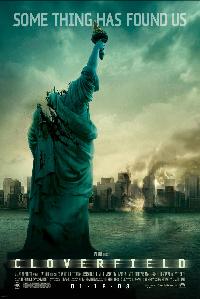 |
| CLICK FOR OFFICIAL SITE |
|
|
Right
away, we are introduced to a past-tense reality, where we know we are
viewing events that have already been studied and preserved.
However, the conscious presence of the "present tense" entity (DOD,
government, whoever edited the tape, etc.) is coolly silent and hidden
from us. The video then jumps to footage of someone examining an
apartment with voice-over from the shooter explaining that it's "Beth's
fathers place." Before we actually see the person behind the camera, we
get to start learning about him from what he chooses to shoot with the
camera. We see still pictures of Beth (before we actually see her) on
the shelf with family portraits. Here begins an interesting observation
on captured realities: we experience the video POV of "Rob" as he
observes someone else's images of Beth and family- in the form of
photographs on the shelf. This dynamic of altering POV's becomes a key
dynamic throughout the film. Next, Rob's camera finds it's way to the real Beth, as he studies her lying asleep in bed. Soon Beth
turns the camera on Robert and the two discuss spending the day in Coney Island. We become privy to what we later learn was
a many splendored one night encounter between the two that sparks an undeclared love relationship.
The
first act is all about establishing the characters and their
interpersonal drama through the eye of Rob's handycam. We
observe the camera change hands a few times before Rob's friend "Hap" is
charged with "documenting" a goodbye video at a going away party. Hap, first-time
video maker, bumbles through his task of bugging everyone with the camera. It also is revealed that he is inadvertantly recording over a previously used tape- the one Rob shot of himself and Beth that day at Coney Island. Slowly, we are pulled into the romantic tension
between Rob and Beth, until it peaks with an argument as she leaves.
What is different in the storytelling than in traditional narrative
films is that we observe everything through the voyeuristic intimacy of
the camera. Sometimes Hap leaves it running while he says he's turned
it off. He'll tell the same story different ways to different people.
We become privy to an honest reality of the characters beyond their
surface appearance. Soon
we know everything we need to know about the characters and their
relations to each other. Rob and Beth obviously have unexpressed and
unresolved feelings, which leads to a tense exchange. Shortly after
Beth and Rob part for the night on bad terms, something epic happens...
Often standard in horror narratives, a fracture in an interpersonal connection becomes externally reflected in the outer world of the story. Monsters, demons and aliens can represent our own inner demons unleashed. In the film SIGNS(2002) Mel Gibson' character is a fallen priest fighting to protect his family from aliens. Gibson's anger at God and loss of faith, has allowed his "demons" to materialize, threatening everyone, until he is able to restore his faith. The betrayal of trust between a husband and wife in 28 DAYS LATER(2007) allows deadly zombies to return and destroy a re-ordered society.
|
As
Rob and his buddies dish about their true feelings on the fire escape,
the city is rocked by a giant explosion. Everyone runs to the roof to
see. A girl asks nervously, "is it another attack?" Clearly,
the story takes place in a post 9/11 America. Flames shoot from
downtown and debris rains down as everyone runs for cover. On the
street, people are in panic as something comes crashing through the
canyons of mid town Manhattan and slams into the street: it's the head
of the Statue of Liberty! The city is clearly under attack! Truly the
decapitated head of the Statue is no accident, but a brazen statement
of aggression. In what is certainly the central image of the film, screams
of horror quickly grow silent as onlookers busy themselves taking cell
phone pictures of the twisted head in the street. Something ominous
passes blocks away and soon a building crashes down, sending forth a huge
cloud of smoke and ash similar to the images captured of the Trade
Towers coming down on Sept 11, 2001. Taking cover in a store front,
Hap's camera keeps rolling as the plume of ash passes- followed by
something else- something big. Hap yells, "i saw it- it's alive!" Outside on the street Marlena is in shock and later mutters: "it was eating people." Everything is covered with ash as shattered buildings are in flames. Hap proclaims, "i got it on video"
and we again jump forward in time (obviously Hap turns the camera off
in order to playback the tape) the video cuts once again to Rob and
Beth's previous footage on their way to visit Coney Island. This
becomes an intermittent occurrence throughout the entire film, slowly
reminding us of the romantic content between Rob and Beth- and that both stories are past tense.
|
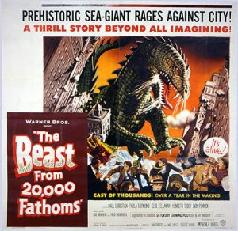 |
| CLICK IMAGE FOR VIDEO |
|
|
As
the gang searched for a way out of Manhattan, they enter an
electronics store in search of cell phone batteries. Television screens around the store broadcast news coverage. We now see oblique images of the creature from sky
chopper cameras, as newscasters are at a loss for words. The military
forces an evacuation and Rob and
friends join a mass exodus across the Brooklyn Bridge (another scene
reminiscent of 9/11 imagery) when the bridge is attacked and Rob's
brother is lost. Taking refuge in the subway tunnels, Hap's camera
secretly observes Rob's heartbreaking phone call to his mom, telling
her
the news of his dead brother. This scene is a sober peek into the
tragedy's impact on one family in the midst of a city wide crisis
(again a 9/11 reference.) The
group decides to abandon safety in favor of trying to rescue their
friend Beth. Hap uses the light on the Handycam to see through the dark
subway tunnels and then later the infrared "nightshot" feature to see in the
dark- and to discover smaller creatures who soon attack them.
|
Is the monster some prehistoric creature from the depths of an ocean trench? is in an alien from another world? Has the government known about this? Could it perhaps be a government or military experiment gone wrong? All of these questions are brought up by the protagonists, yet theories must play second to immediate survival. Happening into an army post, the group finds temporary shelter and a first chance at some information. A sergeant explains, "if they know what's going on, they're not telling me," further adding, "whatever it is- it's winning."
To rescue Beth, the gang must ascend a high-rise in order to cross over to her crashed building. I couldn't help but think of the World Trade Towers and the reality of all those fireman who went inside on rescue missions. Again, CLOVERFIELD offers us an inside look at those sort of untold brave acts in a time of chaos. From Beth's twisted apartment, the gang sees the full creature for the first time. "Don't look," they tell Beth, "you don't wanna see it." Soon after escaping the building, everyone rendezvous with the military to escape the city by helicopter. Stealth fighters bomb the monster as Hap gets it all from aerial view.
|
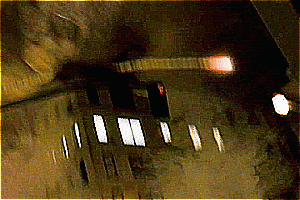 |
| MONSTER FOR A NEW ERA |
|
|
However,
the creature knocks the chopper down and for a full minute or so we observe
footage from the still rolling camera as it lay on it's side in the crash. Finally,
Hap regains consciousness and discovers he is standing beneath the creature in
Central Park! As Rob and Beth yell, Hap is eaten by the monster and we
witness it all from his POV. As the camera falls to the ground, it
comes to rest beside Hap's lifeless face. Rob grabs the camera and
continues rolling as he and Beth run for cover amidst the warning
sirens from the military that the final bombing has begun.
Throughout the drama, Hap never stops rolling the Handycam, embracing his new found role as documentarian. At different times, other characters pick up the camera, but always the camera rolls. "We need to document this- so people will know how it all went down," Hap proclaims. The film offers a meditation on our obsession with capturing events- as if doing so can somehow protect us in the present. Near the film's end, Rob and Beth hunker down in a Central Park tunnel as the military bombs the city. Fearing their own demise, they record video messages for their families. As the tunnel collapses, we hear the two finally express their love to each other as the video cuts out. The last remaining images on the tape again jump back to the original footage at Coney Island. Rob and Beth are happily riding the Ferris wheel and sign off saying, "it was good day." Far off in the background, barely noticeable, something can briefly be seen splashing down into the ocean...
|
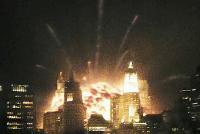 |
| GROUND ZERO |
|
|
 |
| "WHAT'S ATTACKING US?" |
|
|
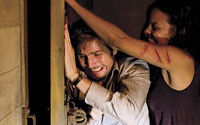 |
| ENEMY AT THE GATES |
|
|
Today
we are in a world where image making in real-time is as much a part of
our lives as putting on our shoes. Whether we are able to conceptually keep up
with our own media or not, we are saturated with images of
ourselves and of ourselves making images. With internet streams, cell
phone cameras and digital technology everywhere, we have little control-
if even the knowledge- of when we are on camera. Gone are the days
where we seemed to mind and when such media culture was new and unique.
Although the "shaky camera" feel of CLOVERFIELD left some viewers a bit
sea-sick, it's doubtful anyone is unfamiliar with the look and feel of
home video camera footage, or the unique realities it presents. From the
Rodney King Beating in the Late 1980's, to the success of THE BLAIR
WITCH PROJECT's pseudo-video documentary style and the many thousands
of images we've seen from 9/11- the home-video "look-of-crisis" is a
well engrained part of our social psyche.
What makes
CLOVERFIELD so clever is the juxtaposition of epic monster movie with
voyeuristic handycam point-of-view. This idea could either fail by stripping away the suspension of dibelief so easily created with the big-budget look of film- or create a very powerful super-realism that
could heighten the drama. For CLOVERFIELD, the latter proved true.
Perhaps in the 80's, "video-verite" would by high-concept, but today's
audiences are well jaded to the dynamics of "reality TV."
CLOVERFIELD feels a bit like an episode of Fox TV's "COPS," only with a giant
monster that shows up and wrecks the place. Director Matt Reeves explained this approach:
"We wanted this to be
as if someone found a Handycam, took out the tape and put it in the
player to watch it. What you're watching is a home movie that then
turns into something else." Reeves explained that the pedestrians
documenting the severed head of the Statue of Liberty with the camera
phones was reflective of the contemporary period. According to him:
"Cloverfield very much speaks to the fear and anxieties of our time,
how we live our lives. Constantly documenting things and putting them
up on YouTube, sending people videos through e-mail – we felt it was
very applicable to the way people feel now."
(from Wikipedia)
|
Certainly
the wow-factor of any monster movie is the absurdism of a giant creature showing up in our modern world. (KING KONG, JURASSIC PARK,
JURASSIC PARK: LOST WORLD, THE HOST, WAR OF THE WORLDS, GODZILLA) The monster is showcased against familiar settings and backdrops we know from real life. The question becomes: how could this be? and calls into question everything about our
knowledge, our faith, our science and understanding. All attempts to answer this question lead us toward the premise of the drama and the message of the story. This dynamic in
horror/sci-fi/fantasy allows us to observe human nature from outside of
it. Particularly in horror, viewers get the catharsis of edging close to our fears, only in a completely imaginary way. CLOVERFIELD takes this kind of drama into an edgy realism we
haven't seen before in movies- but certainly have seen in the footage of TV, the internet and our own home videos. Almost every scene
in the film could be taken as a reference to the look and feel of 9/11.
The references also extend to many of the images since 9/11 such as the war in Iraq, hostage footage posted by terrorists, the Indonesian Typhoon or the events of Hurricane Katrina. The characters in CLOVERFIELD are wiser and more resourceful than
conventional horror film characters because they are already well versed on this modern phenomenon of digital culture- they have already lived
this reality before. In this way, the film is not just metaphor or
allegory to the climate of our culture, but much more directly- almost
a re-telling of sorts. Director Matt Reeves addressed this concept of
self-awareness:
"There's
a moment on the Brooklyn Bridge, and there was a guy filming something
on the side of the bridge, and Hud sees him filming and he turns over
and he sees the ship that's been capsized and sees the headless Statue
of Liberty, and then he turns back and this guy's briefly filming him.
In my mind that was two movies intersecting for a brief moment, and I
thought there was something interesting in the idea that this incident
happened and there are so many different points of view, and there are
several different movies at least happening that evening and we just
saw one piece of another." (from Wikipedia)
|
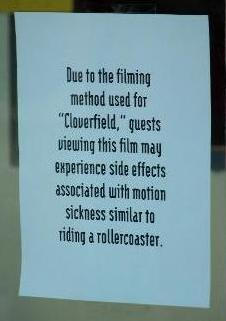 |
| SIGNS AT THEATERS |
|
|
Reeves also added: "While we were on set making the film we talked about
the possibilities and directions of how a sequel can go. The fun of
this movie was that it might not have been the only movie being made
that night, there might be another movie! In today?s day and age of
people filming their lives on their camera phones and Handycams,
uploading it to YouTube? That was kind of exciting thinking about that."
There is no music in CLOVERFIELD until the end credits. After the music subsides and the credits come to an end, there is the faint sound of static and voices- as if to hint that the camera survived the the cave in. Is there more footage to be seen? Who are the voices?? When played in reverse, the voice is Rob clearly saying: "it's still alive!" (to listen, click HERE )
|
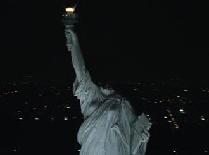 |
| SIGN OF THE TIMES? |
|
| |
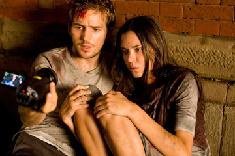 |
| MESSAGE IN A BOTTLE |
|
|
LIBERTY IN PERIL! The Statue of Liberty in New York City has often been used for symbolic imagery in science fiction and horror films. The statue is of course a worldly symbol of American liberty and the ideals of Democracy and freedom. The statue is also a poignant structure because it represents an accomplished feat of human design and engineering. One glance at the statue instantly conveys the notion of a highly developed and self-aware civilization. Before these concept however, the statue is foremost a human likeness. PLANET OF THE APES(1968) used all these factors in it's famous ending reveal of the statue protruding from a sandy burial in a distant apocalyptic future. CLOVERFIELD's producer/creator J.J. Abrams cited the poster image from John Carpenter's ESCAPE FROM NEW YORK as inspiration for CLOVERFIELD.
|
(L to R) PLANET OF THE APES (1968) ESCAPE FROM NEW YORK (1981) A.I. (2001) DEEP IMPACT (1998) THE DAY AFTER TOMORROW (2004) INDEPENDENCE DAY (1996) AFTERSHOCK (1999)
|
I AM LEGEND (2007)
dir: Francis Lawrence (CONSTANTINE)
Sci-fi fans will recognize this as a remake of THE OMEGA MAN (1971) starring Charlton Heston, also based on Richard Matheson's 1954 novel "I AM LEGEND."
One man's journey toward faith at the end of the world. Robert Neville (Will Smith) is the last survivor in New York City "ground zero" who was too late to stop a mutating virus from wiping the earth clean of humans. The small percentage of survivors either mutated into cannibalistic creatures or were eaten by them. Robert remains in the apartment where he lived with his wife and daughter and works tirelessly in his basement lab to further his work in finding a viral cure. Despite his obsessive daily regimen, his results are fruitless. When a pair of fellow survivors appear, Robert is challenged to look at unfolding events as divinely inspired. "There is no God," Robert asserts, while his compatriot Anna replies, "the world is quieter now, it's easier to listen." Everything in Robert's tightly controlled world unravels and in an act to defend his long sought after viral cure, embraces faith once and for all.
Following in the footsteps of many great horror/sci-fi epics, I AM LEGEND chronicles the empty life of a once faithful man who has turned his back on God. While Robert declares "God didn't do this- we did" it is not God who has turned his back, but Robert himself- by asserting the solution must come from man alone. Robert separated from his wife and daughter in order to stay behind and work a cure- and they died without him. Robert burdens himself with saving the world in the memory of his deceased family who believed in him. When his beloved dog "Sam" - the only remaining member of his family - is killed defending him, Robert for the first time, lets go and gives in to his anger. This is the exact moment he hands himself over to his demons- but is in turn saved by fellow humans who heard his radio message and came to find him. "Could this possibly be coincidence?" Anna asks, "there must be a reason."
| |
GRINDHOUSE: PLANET TERROR (2007)
dir: Robert Rodriguez (SIN CITY, SPY KIDS IN 3-D, EL MARIACHI)
A must see! A total masterpiece of b-movie satire. Described as "a
love note to John Carpenter," this spoof hits the bullseye with it's
send up of ESCAPE FROM NEW YORK, TEXAS CHAINSAW MASSACRE and every
zombie film ever. Rodriguez even goes so far as to scratch up the film
and add purposely jump cut bad edits to give the full "grindhouse" film
effect. Too many hysterical moments to list here, suffice to say the
casting, acting, design and score all work perfectly. The extended DVD
edition does go a bit over the top, particularly (no surprise here)
with a scene featuring Quentin Tarrantino as an actor. I fully
recommend!
special note: at the beginning of the DVD is a mock movie trailer that is to die for.
| |
|
|
|
GRINDHOUSE: DEATH PROOF (2007)
dir: Quentin Tarrantino (KILL BILL vol. 1 & 2, PULP FICTION, RESERVOIR DOGS)
Totally sucked. I'm not sure why anyone likes Quentin Tarrantino's work other than he's a bit of "The Emperor's New Clothes" kinda thing. His films are so radically stylized in their plodding ponderance that the un-initiated mistake this for depth. I think film buffs like him because his films are about films. To me, he's less the clever genius and more the kid in back of class firing spitballs at your neck. This film is so utterly boring and nonsensical that whatever premise it sets up is quickly undermined. Kurt Russell does a pleasant job as a murderous daredevil, but again, the pacing stifles all. Tarrantino's dialogue and tongue-in-cheek homages to cheese-all cinema are not only tired here, but insulting. Dude- grow up!
| |
NIGHT SKIES (2007)
dir: Roy Knyrim (CEMETERY GATES, DEMONS AT THE DOOR)
Got better as it went along. So cheesy in the first act (mostly due to limited production value) that i contemplated ejecting the DVD. However, it improved. In fact, the third act was rather stirring- with quite a harsh ending. Using the mysterious lights in the Arizona sky a few years back as it's set up, a group of travelers break down and get ambushed by alien invaders. It's basic straight-to-video horror for the most part, until we go inside an alien craft to witness the horrific nature of the experiments the aliens perform on their human captives. I suppose i would recommend this with dubious amounts of alcohol and a handful of other rentals at the same time.
note: recently an Arizona man stepped forward to admit he created the mysterious lights in the sky by attaching flashlights to balloons on a dare.
| |
|